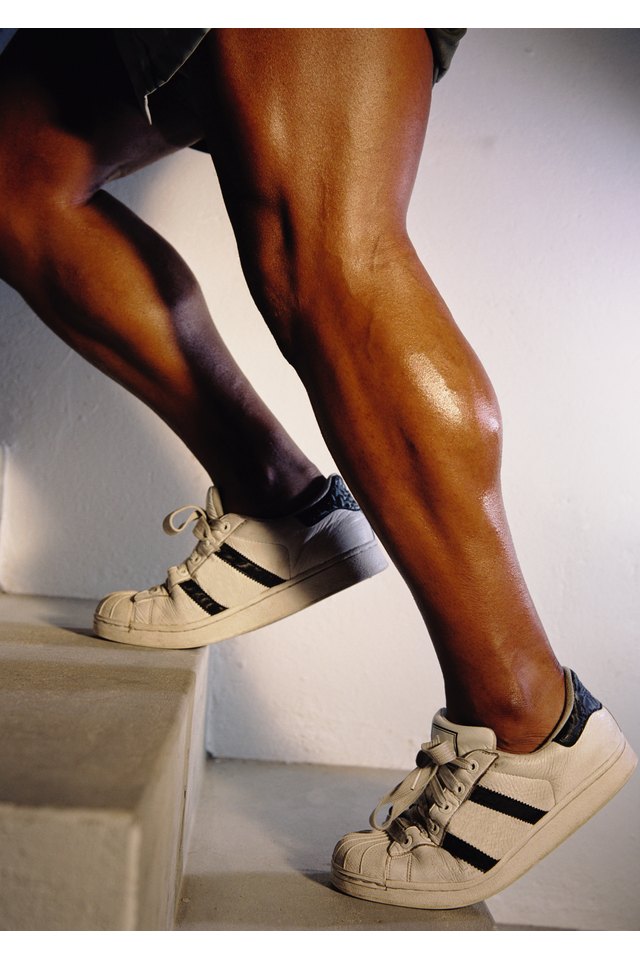Eccentric Exercises for Peroneals

The peroneals (PER-own-ee-uls) are a group of muscles located on the outside of your lower leg. These muscles function to rotate your ankle outward. Eccentric exercises occur when a muscle creates force while lengthening, rather than shortening like in concentric exercises. Eccentric exercises are particularly effective in shock absorption and rapid deceleration, and they greatly enhance the benefits of resistance training. If eccentric exercises for the peroneals are being used for rehabilitation purposes, it is important to have a health care professional properly incorporate them into a program.
Seated Peroneal Strengthening
To avoid the addition of body weight during peroneal strengthening, sit on the floor. Attach a resistance band around the mid-point of your right foot. Attach the other end of the resistance band to a fixed point located on the outside of your right foot. Make sure the band is taut. Begin with your leg stretched out in front of you and your heel on the floor. Point your toes toward the ceiling. This is your starting position. Rotate your ankle outward, keeping your toes facing the ceiling. Once it cannot rotate any further, slowly rotate the ankle inward, back to the starting position. This movement is the eccentric motion, for the peroneals are lengthening against the resistance. Repeat eight to 12 times.
Standing Peroneal Strengthening
A similar eccentric exercise can be done while standing. For this exercise, use a BAPS board. BAPS stands for biomechanical ankle platform system, which is a piece of exercise equipment designed to improve balance. Place both feet evenly on the BAPS board. Place your hands on a support for additional balance. Start with the BAPS board resting on the ground on the right side. Slowly try to lift the right side off the ground and lower the left side of the BAPS board to the ground. Practice this weight-shifting exercise eight to 12 times on each side.
Progressive Peroneal Strengthening
Ankle weights are an effective tool for lower-body progression exercises because they allow for variance in weight resistance and they are easy to use. As an example, a light weight provides a transition exercise from stretching to weight-bearing in a rehabilitation program, while a heavier weight targets peroneal development for sport-specific training. To begin, attach an ankle weight to the mid-point of your right foot and lie on a table on your left side. Bend your left knee to support your right leg. Keeping your toes facing forward, rotate your ankle upward toward the ceiling and slowly lower your ankle back down. Repeat eight to 12 times with each foot.
Modified Peroneal Strengthening
Sit comfortably in a chair with your knees bent at 90 degrees, your feet approximately hip-width apart and your feet flat on the ground. Place your right foot in the middle of a towel and hold both ends in your left hand. This is your starting position. Keeping a firm grasp on the towel with your left hand, rotate your right ankle outward, keeping your toes facing forward. Next, while maintaining the resistance in the towel, rotate your ankle inward, back to the starting position. Repeat eight to 12 times with each foot. Using a towel will allow you to easily control and modify the amount of resistance applied during the exercise.
References
- Treat Yourself to Pain Free Living; Julie Donnelly, L.M.T.
- Encyclopedia of International Sports Studies; Roger Bartlett, Chris Gratton, and Christer G. Rolf
- Myofascial Pain and Dysfunction; Janet G. Travell, M.D. and David G. Simons, M.D.
- The Scientific and Clinical Application of Elastic Resistance; Philip Page and Todd S. Ellenbecker
Resources
- Biomechanics in Sport: Eccentric Muscle Action in Sport and Exercise; B.I. Prilutsky
Writer Bio
Erika McAuley is a freelance writer from Abbotsford, British Columbia. As an exercise rehabilitation professional, she has been preventing and treating musculoskeletal injuries in athletes and civil workers since 2008. McAuley holds a Bachelor of Human Kinetics in athletic therapy from Trinity Western University and an Advanced Certificate in Athletic Therapy from Mount Royal University.
